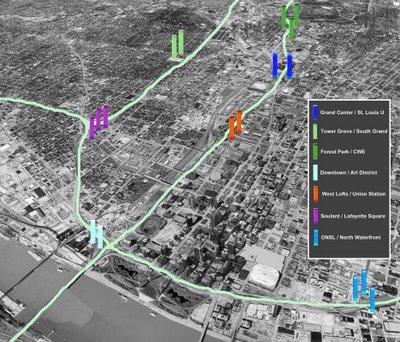
{placemaking with lighted towers at LAX}
Where is the entrance to Grand Center and St. Louis University from I-64? Where is Soulard? How do I find Tower Grove Park? I believe that enhancing the sense of place in our central city would help orient visitors and provide residents with meaningful landmarks. The city once did this with water towers and three fantastic examples can still be seen in St. Louis. Church steeples have played similar roles in defining a neighborhood or parish.
I’m stealing the idea from a design competition for Indianapolis. The bottom image is from that proposal and the objective was to provide directional landmarks for downtown Indianapolis. As in the Indianapolis design competition, the towers would be painted and illuminated at night by LEDs (the same lights used on the Lumiere Casino Hotel, but toned-down a bit).
The light towers would serve as gateways to nodes in our city. Landmarks such as these are instantly more memorable than highway signs. Signs hold zero interest. Think of your last trip to Chicago. Do you think, “There’s always a good place to park if I turn onto East Jackson Boulevard.” or do you remember that if you turn just after passing Buckingham Fountain there is a parking garage that always has spaces available? Instead of telling someone to look for the “Hampton Avenue” sign you could say, “you’ll see the green towers for Forest Park then you take the next exit.”
I could go on, but I suppose you get the idea. Sense of place is important for visitors and residents alike and St. Louis would benefit from some creative thinking as to how to better define places in our city.

